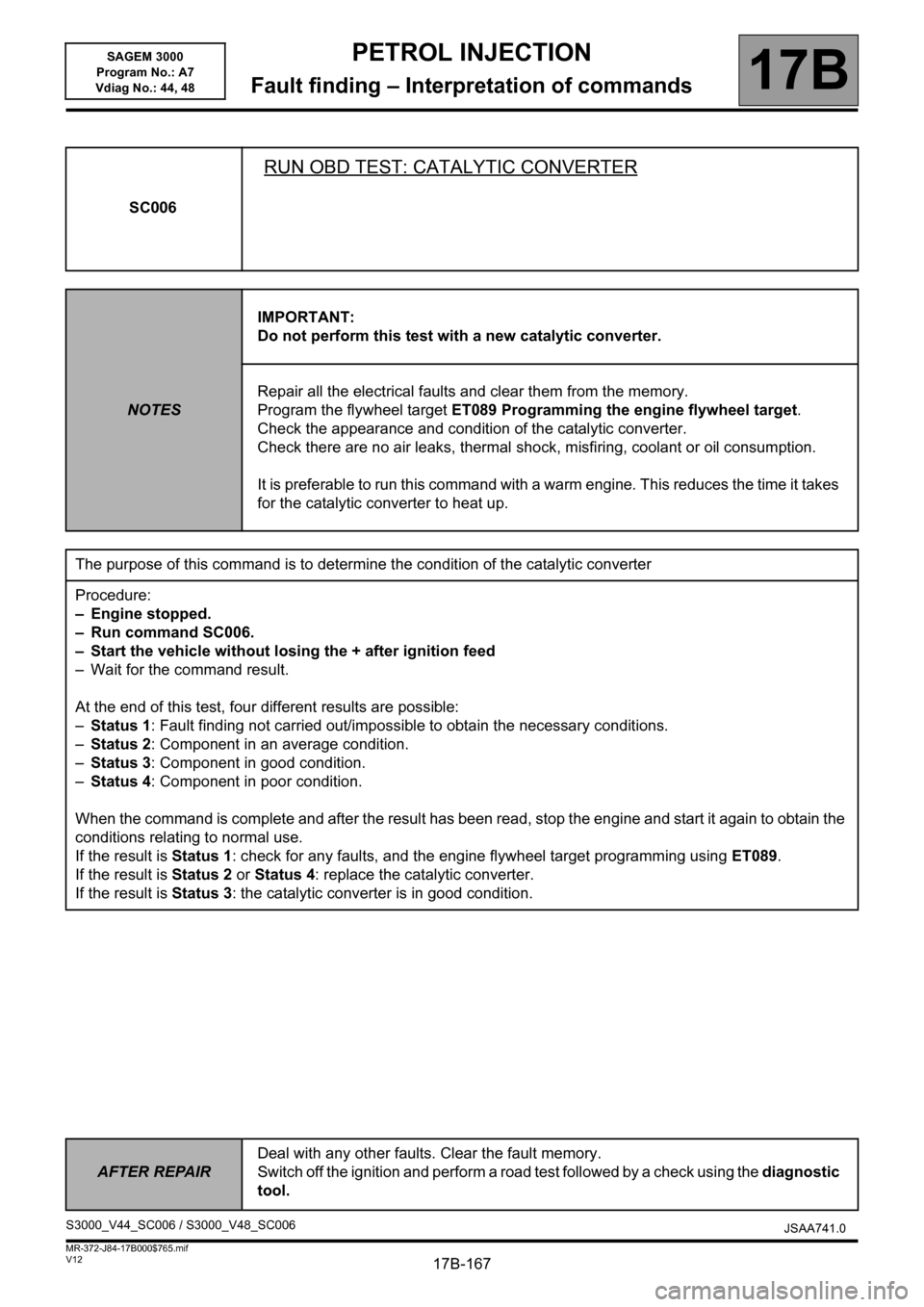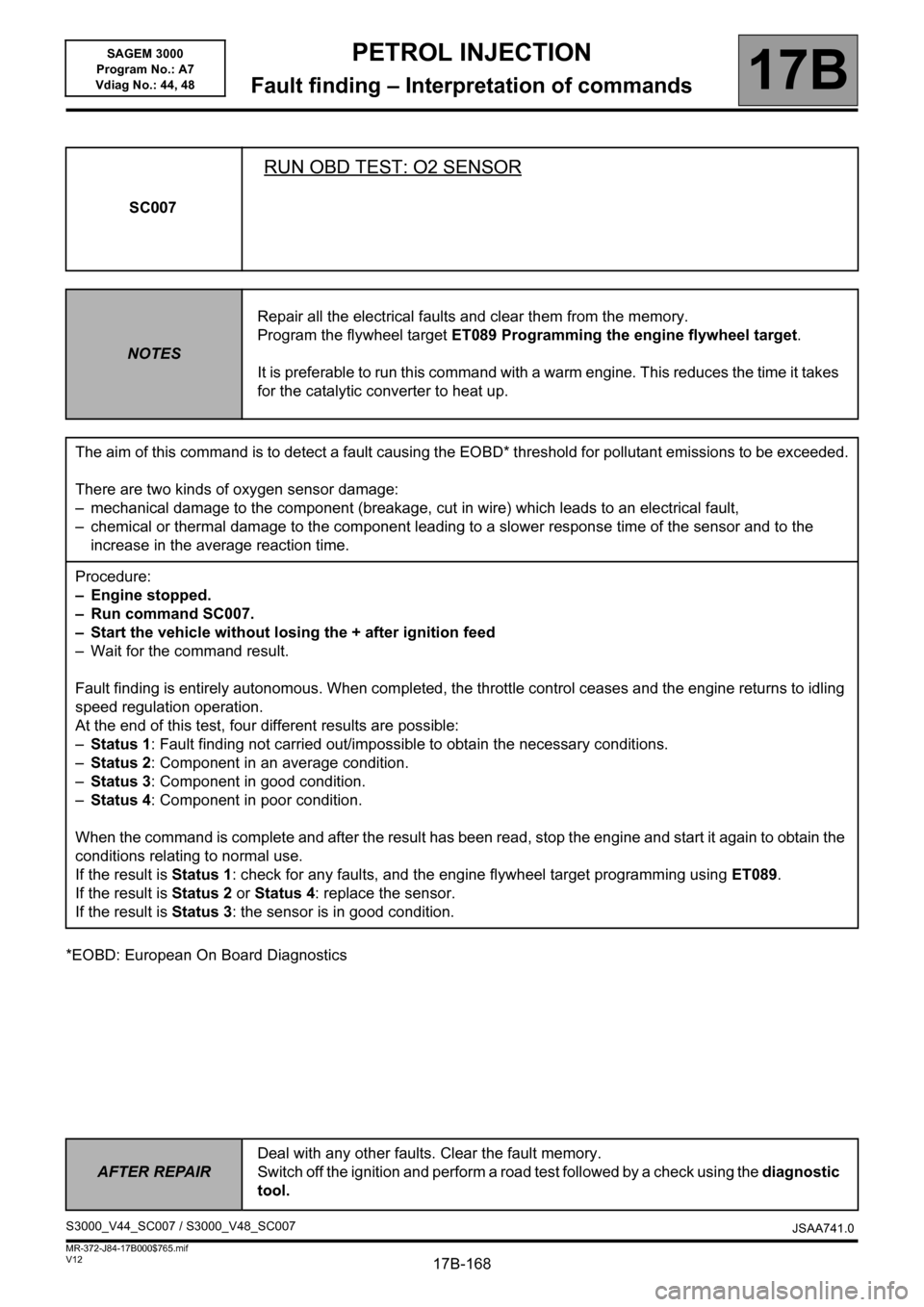S3000 RENAULT SCENIC 2014 J95 / 3.G Petrol Injection - Sagem3000 User Guide
[x] Cancel search | Manufacturer: RENAULT, Model Year: 2014, Model line: SCENIC, Model: RENAULT SCENIC 2014 J95 / 3.GPages: 181
Page 90 of 181

PETROL INJECTION
Fault finding – Conformity check17B
17B-90V12 MR-372-J84-17B000$450.mif
SAGEM 3000
Program No.: A7
Vdiag No.: 44, 48PETROL INJECTION
Fault finding – Conformity check
MAIN COMPUTER STATUSES AND PARAMETERS
NOTESOnly check conformity after a thorough check with the diagnostic tool.
The values shown in this conformity check are given as a guide. Application
condition: engine off, ignition on.
Order FunctionParameter or Status
Checked or ActionDisplay and notes Fault finding
1
Battery
voltagePR071: Computer
feed voltage11V
interpretation of PR071
Computer supply
voltage. 2 ET001: Computer +
after ignition
feedPresence of + After
ignition feed
Absent
3Water
pumpET543: Coolant
pump controlFor F4R Turbo engine only.
ACTIVE: coolant pump
running
INACTIVE: coolant pump idle.In the event of a fault, apply
interpretation of DF086
Coolant pump relay
control circuit.
4Vehicle
speedPR089: Vehicle
speedGives the vehicle speed in
mph (km/h). This parameter
is sent to the injection by
the ABS computer via the
multiplex network.If there is a fault use the
interpretation for DF091
Vehicle speed signal.
5Clutch
contactET040: Clutch pedalIndicates recognition of
clutch pedal contacts.
RELEASED: Pedal released
DEPRESSED: Pedal
depressed
UNAVAILABLE: Automatic
transmission onlyIn the event of a fault, use
the interpretation of ET040
Clutch pedal.
S3000_V44_CCONF/S3000_V48_CCONFJSAA741.0
MR-372-J84-17B000$450.mif
Page 167 of 181

17B-167
AFTER REPAIRDeal with any other faults. Clear the fault memory.
Switch off the ignition and perform a road test followed by a check using the diagnostic
tool.
V12 MR-372-J84-17B000$765.mif
17B
SAGEM 3000
Program No.: A7
Vdiag No.: 44, 48
SC006
RUN OBD TEST: CATALYTIC CONVERTER
NOTESIMPORTANT:
Do not perform this test with a new catalytic converter.
Repair all the electrical faults and clear them from the memory.
Program the flywheel target ET089 Programming the engine flywheel target.
Check the appearance and condition of the catalytic converter.
Check there are no air leaks, thermal shock, misfiring, coolant or oil consumption.
It is preferable to run this command with a warm engine. This reduces the time it takes
for the catalytic converter to heat up.
The purpose of this command is to determine the condition of the catalytic converter
Procedure:
– Engine stopped.
– Run command SC006.
– Start the vehicle without losing the + after ignition feed
– Wait for the command result.
At the end of this test, four different results are possible:
–Status 1: Fault finding not carried out/impossible to obtain the necessary conditions.
–Status 2: Component in an average condition.
–Status 3: Component in good condition.
–Status 4: Component in poor condition.
When the command is complete and after the result has been read, stop the engine and start it again to obtain the
conditions relating to normal use.
If the result is Status 1: check for any faults, and the engine flywheel target programming using ET089.
If the result is Status 2 or Status 4: replace the catalytic converter.
If the result is Status 3: the catalytic converter is in good condition.
S3000_V44_SC006 / S3000_V48_SC006
JSAA741.0
PETROL INJECTION
Fault finding – Interpretation of commands
Page 168 of 181

17B-168
AFTER REPAIRDeal with any other faults. Clear the fault memory.
Switch off the ignition and perform a road test followed by a check using the diagnostic
tool.
V12 MR-372-J84-17B000$765.mif
PETROL INJECTION
Fault finding – Interpretation of commands17B
SAGEM 3000
Program No.: A7
Vdiag No.: 44, 48
*EOBD: European On Board DiagnosticsSC007
RUN OBD TEST: O2 SENSOR
NOTESRepair all the electrical faults and clear them from the memory.
Program the flywheel target ET089 Programming the engine flywheel target.
It is preferable to run this command with a warm engine. This reduces the time it takes
for the catalytic converter to heat up.
The aim of this command is to detect a fault causing the EOBD* threshold for pollutant emissions to be exceeded.
There are two kinds of oxygen sensor damage:
– mechanical damage to the component (breakage, cut in wire) which leads to an electrical fault,
– chemical or thermal damage to the component leading to a slower response time of the sensor and to the
increase in the average reaction time.
Procedure:
– Engine stopped.
– Run command SC007.
– Start the vehicle without losing the + after ignition feed
– Wait for the command result.
Fault finding is entirely autonomous. When completed, the throttle control ceases and the engine returns to idling
speed regulation operation.
At the end of this test, four different results are possible:
–Status 1: Fault finding not carried out/impossible to obtain the necessary conditions.
–Status 2: Component in an average condition.
–Status 3: Component in good condition.
–Status 4: Component in poor condition.
When the command is complete and after the result has been read, stop the engine and start it again to obtain the
conditions relating to normal use.
If the result is Status 1: check for any faults, and the engine flywheel target programming using ET089.
If the result is Status 2 or Status 4: replace the sensor.
If the result is Status 3: the sensor is in good condition.
S3000_V44_SC007 / S3000_V48_SC007
JSAA741.0